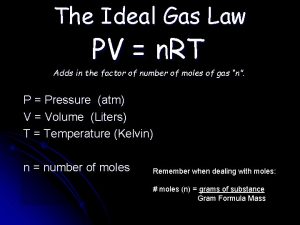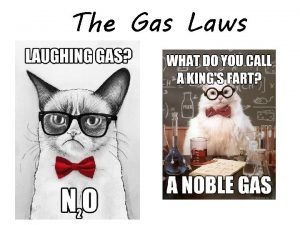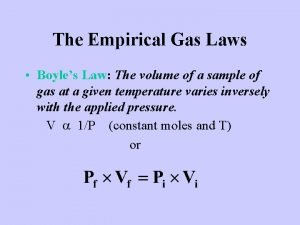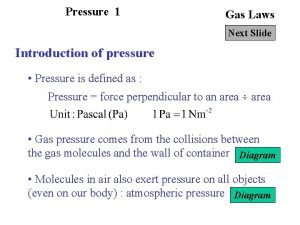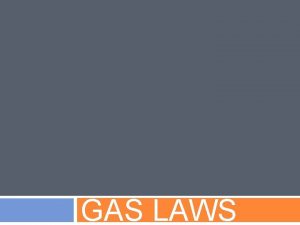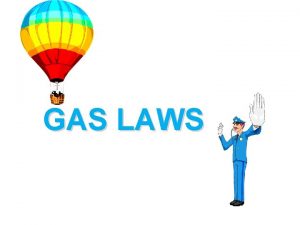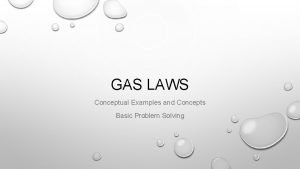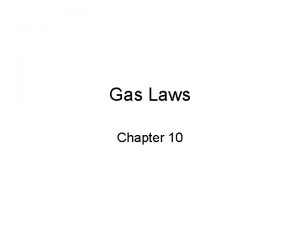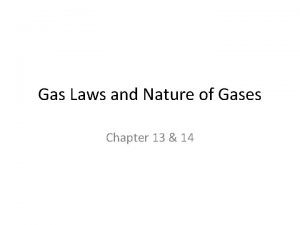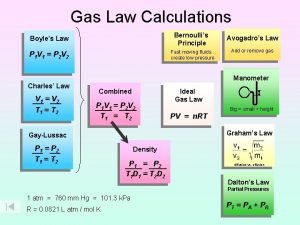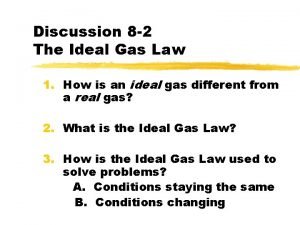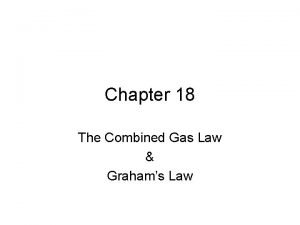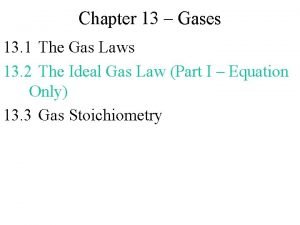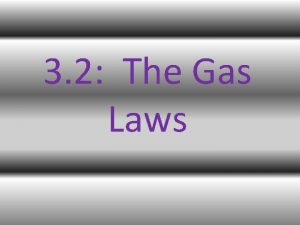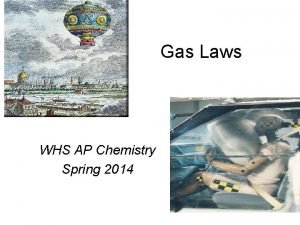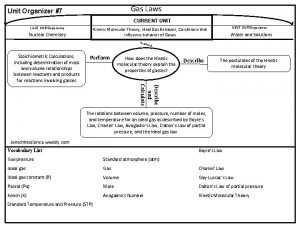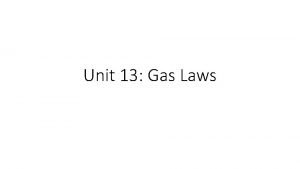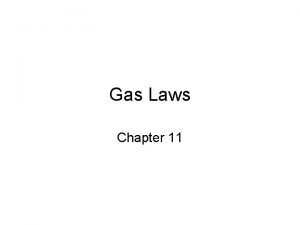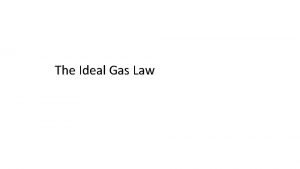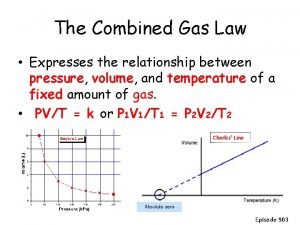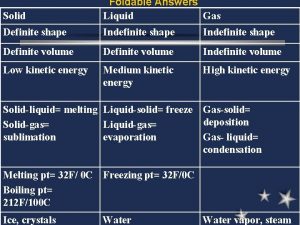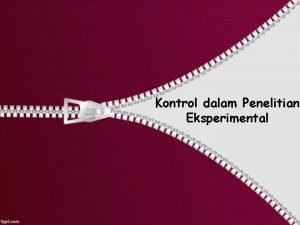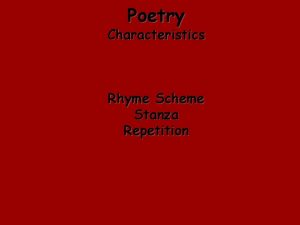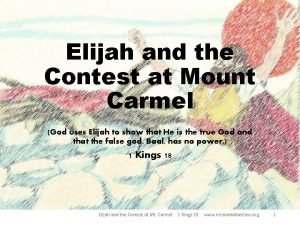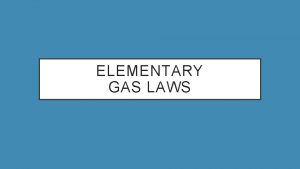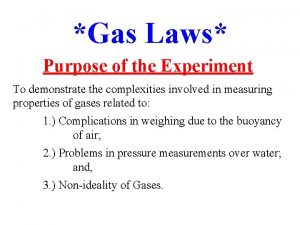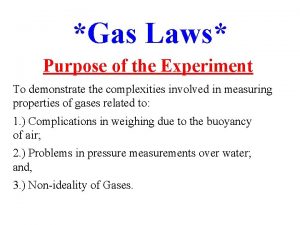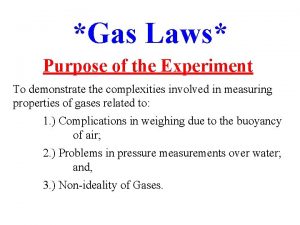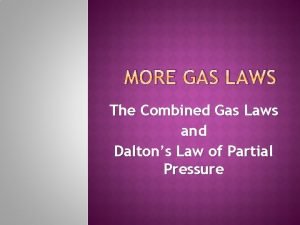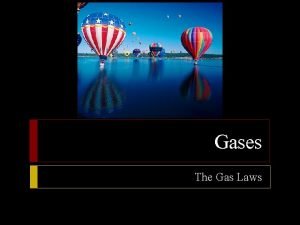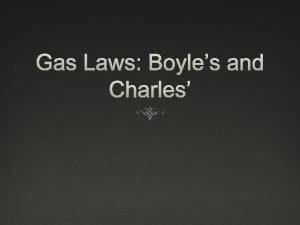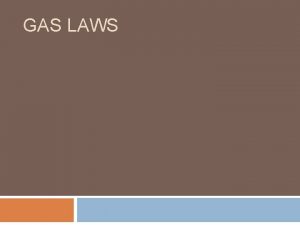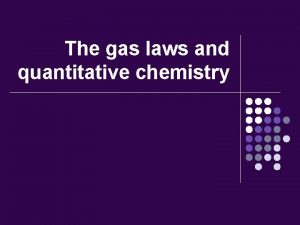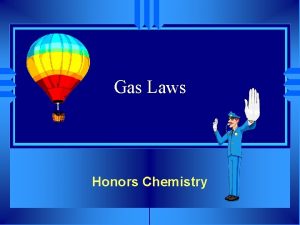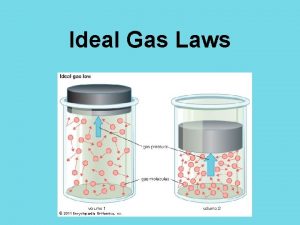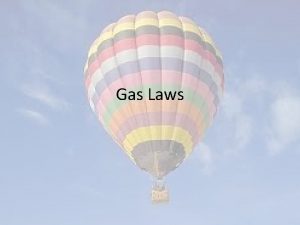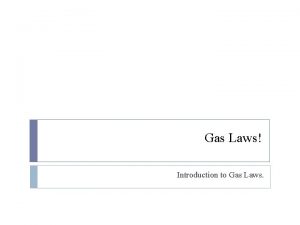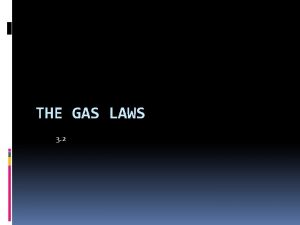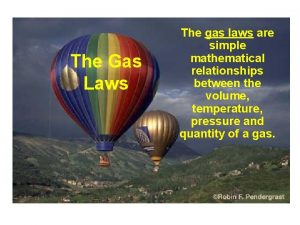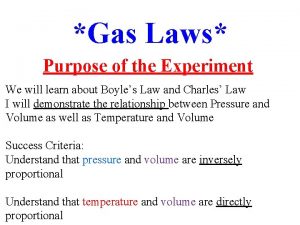Gas Laws Purpose of the Experiment To demonstrate











































- Slides: 43

*Gas Laws* Purpose of the Experiment To demonstrate the complexities involved in measuring properties of gases related to: 1. ) Complications in weighing due to the buoyancy of air; 2. ) Problems in pressure measurements over water; and, 3. ) Non-ideality of Gases.

Physical Characteristics of Gases Physical Characteristics Volume, V Typical Units liters (L) Pressure, P Temperature, T atmosphere (1 atm = 1. 015 x 105 N/m 2) Kelvin (K) Number of atoms or molecules, n mole (1 mol = 6. 022 x 1023 atoms or molecules)

Boyle’s Law Pressure and volume are inversely related at constant temperature. PV = K As one goes up, the other goes down. P 1 V 1 = P 2 V 2 “Father of Modern Chemistry” Robert Boyle Chemist & Natural Philosopher Listmore, Ireland January 25, 1627 – December 30, 1690

Boyle’s Law: P 1 V 1 = P 2 V 2

Boyle’s Law: P 1 V 1 = P 2 V 2

Charles’ Law Volume of a gas varies directly with the absolute temperature at constant pressure. V = KT V 1 / T 1 = V 2 / T 2 Jacques-Alexandre Charles Mathematician, Physicist, Inventor Beaugency, France November 12, 1746 – April 7, 1823

Charles’ Law: V 1/T 1 = V 2/T 2

Charles’ Law: V 1/T 1 = V 2/T 2

Avogadro’s Law At constant temperature and pressure, the volume of a gas is directly related to the number of moles. V = K n V 1 / n 1 = V 2 / n 2 Amedeo Avogadro Physicist Turin, Italy August 9, 1776 – July 9, 1856

Avogadro’s Law: V 1/n 1=V 2/n 2

Gay-Lussac Law At constant volume, pressure and absolute temperature are directly related. P=k. T P 1 / T 1 = P 2 / T 2 Joseph-Louis Gay-Lussac Experimentalist Limoges, France December 6, 1778 – May 9, 1850

Dalton’s Law The total pressure in a container is the sum of the pressure each gas would exert if it were alone in the container. The total pressure is the sum of the partial pressures. PTotal = P 1 + P 2 + P 3 + P 4 + P 5. . . (For each P = n. RT/V) John Dalton Chemist & Physicist Eaglesfield, Cumberland, England September 6, 1766 – July 27, 1844

Dalton’s Law

Vapor Pressure Water evaporates! When that water evaporates, the vapor has a pressure. Gases are often collected over water so the vapor pressure of water must be subtracted from the total pressure.

Differences Between Ideal and Real Gases Obey PV=n. RT Ideal Gas Real Gas Always Only at very low P and high T Small but nonzero Molecular volume Zero Molecular attractions Zero Small Molecular repulsions Zero Small

Real Gases Real molecules do take up space and do interact with each other (especially polar molecules). Need to add correction factors to the ideal gas law to account for these.

Ideally, the VOLUME of the molecules was neglected: Ar gas, ~to scale, in a box 3 nm at 1 Atmosphere Pressure at 10 Atmospheres Pressure at 30 Atmospheres Pressure

But since real gases do have volume, we need: Volume Correction The actual volume free to move in is less because of particle size. More molecules will have more effect. Corrected volume V’ = V – nb “b” is a constant that differs for each gas.

Pressure Correction Because the molecules are attracted to each other, the pressure on the container will be less than ideal. Pressure depends on the number of molecules per liter. Since two molecules interact, the effect must be squared.

Van der Waal’s equation Corrected Pressure Corrected Volume “a” and “b” are determined by experiment “a” and “b” are different for each gas bigger molecules have larger “b” “a” depends on both size and polarity Johannes Diderik van der Waals Mathematician & Physicist Leyden, The Netherlands November 23, 1837 – March 8, 1923

Compressibility Factor The most useful way of displaying this new law for real molecules is to plot the compressibility factor, Z: For n = 1 Z = PV / RT Ideal Gases have Z = 1

Part 1: Molar Volume of Butane Page 72 -73 in your Green Book

Molar mass of butane (C 4 H 10) = _____ g/mole Mass of butane: _____ n or n. B= _______

Molar mass of butane (C 4 H 10) = _____ g/mole (12. 011 4) + (1. 008 10) = 58. 124 Mass of butane: _____ Initial weight of cartridge – final weight of cartridge n or n. B= _______

Ask your TA for the Lab temperature and Pressure* T = ____ o. C P = _____torr V = _____L T = ____ K P = _____atm 0. 500 L Note: K = o. C + 273. 15 & 1 atm = 760 torr Apparent molar volume, (Vm = V / n) of butane at experimental T & P: 0. 500 L Vm = ____ L / mole V/n n → Calculated earlier *These will be posted on the chalkboard. Verify the values are for your session before posting in your book.

Apparent molar volume of butane at STP; Vm = _____L/mole Lab pressure 0. 500 L 1 atm or 760 torr calculate Lab temperature (K) calculate 273. 15 K V 2 Already calculated

Partial pressure of water vapor in flask: Pw = ______torr calculate Lab temperature (K)

Partial pressure of butane in flask: _____ torr _____atm calculate PB = Ptotal -Pw Lab pressure (torr) calculated in previous step (torr)

Partial pressure of butane: Pvdw = ____ atm 0. 08206 L. atm/mole. K Already calculated Lab temp. 14. 47 atm. L 2/mole 2 calculate 0. 500 L 0. 1226 L/mole

Compressibility factor for butane : ZB = ____ Partial pressure of butane in flask (atm) Calculated earlier 0. 500 L calculate same as “n” already calculated Lab temperature (K) 0. 08206 L. atm/mole. K

Estimated second Virial Coefficient for Butane at room temperature: BB = ______L/mole 0. 500 L calculate already calculated Calculated in previous step Compressibility factor for butane

Part 2: Buoyancy Effect Filling Ziplok bag with butane gas Page 75 in your Green Book

Initial mass cartridge____g bag _____ g Final mass ____g _____g Change in mass ____g _____g Discrepancy is the difference between these two masses Discrepancy: _____g Moles of Butane in bag: n = _____ moles Change in cartridge mass calculate 58. 124 g/mole

Calculated volume of Butane in bag: ____L Calculated in previous step calculate Estimated second Virial Coefficient for Butane at room temperature Calculated in Part 1 (p 73). Compressibility factor for Butane Calculated in Part 1 (p 73).

Estimated density of air at experimental T and P: d= ____g / L Buoyancy effect of displaced volume of air (the mass discrepancy) calculate Calculated volume of Butane in bag (calculated in previous step)

Estimated Molar mass of air: _____g/mole Estimated density of air (calculated in previous step) 0. 08206 L. atm/mole. K Lab temperature (K) calculate Lab pressure (atm)

Part 3: Conservation of Mass Gas generating reaction in a closed system Page 77 in your Green Book

Part 3: Conservation of Mass Gas generating reaction in a closed system Molar mass of Na. HCO 3 : _____g/mole Moles of Na. HCO 3: _______ mole

Part 3: Conservation of Mass Gas generating reaction in a closed system Molar mass of Na. HCO 3 : _____g/mole (22. 990) + (1. 008) + (12. 011) + (3 15. 999) = 84. 006 g/mole Moles of Na. HCO 3: _______ mole

Weight of bag and reaction components: Before reaction: _____ g after reaction : ______ g Discrepancy is the difference between these two weights. Discrepancy: _____g Estimated volume of expansion: _______ L calculate Determined in Part 2 (p 75).

Reaction: 1 Na. HCO 3(aq) + CH 3 CO 2 H(aq) _____ + 1 CO 2(g) + ______ Expected moles of CO 2(gas) : ______ moles Expected volume of gas at laboratory T & P: _____L 0. 08206 L. atm/mole. K Expected moles of CO 2 (from previous step) calculate Lab temp. (K) Lab pressure (atm) Partial pressure of water vapor. (Note: Convert your Pw to atm. ) (You calculated Pw in torr in Part 1 – p 73. )

Check Out from the Stockroom 1000 ml beaker 500 ml volumetric flask Tygon tubing with Hook Butane cylinder 1 piece of plastic wrap 1 quart Ziploc Bag 5 dram vial with lid* In The Hood: 50% Acetic Acid in a 500 ml plastic dispenser By Balances: Sodium bicarbonate, Na. HCO 3 Clean Up: *Dispose of liquid waste in appropriate container. Rinse vial and lid with water and return them to the stockroom. Hazards: 50% Acetic acid (corrosive, sharp, irritating odor) Butane (flammable) Waste: 5 gallon liquid waste for Na. HCO 3 and acetic acid

For Next Week – March 5 -8 Read: Thermochemistry (Heat of Neutralization & Heat of Fusion) pp 1 -17 – Chapter 1 in the Green Book Turn In: Gas Laws Experiment pp. 73 -77 + calculations page. Calculations must be shown on a separate piece of paper, with units to the correct number of significant figures. Datasheets need to be in ink, but calculations may be done with pen or pencil. Calculations scribbled in the margins of the lab pages are NOT ACCEPTABLE.
 Useless laws weaken the necessary laws
Useless laws weaken the necessary laws Gas laws crash course
Gas laws crash course Direct or indirect relationship
Direct or indirect relationship Stp gas laws
Stp gas laws What is the combined gas law
What is the combined gas law All the gas laws
All the gas laws Different gas laws
Different gas laws Avogrados law
Avogrados law Gas law conceptual questions
Gas law conceptual questions Boyle's law finding v2
Boyle's law finding v2 Combined gas law
Combined gas law A gas occupies 473 cm3 at 36°c. find its volume at 94°c
A gas occupies 473 cm3 at 36°c. find its volume at 94°c Different gas laws
Different gas laws Combined gas laws
Combined gas laws Chapter 13 gases
Chapter 13 gases Boyle's law states that
Boyle's law states that Charles law formula
Charles law formula Ap chemistry gas laws
Ap chemistry gas laws Gas laws graphic organizer
Gas laws graphic organizer Gas laws hot air balloon
Gas laws hot air balloon Unit 13
Unit 13 Kmt gas laws
Kmt gas laws Gas laws formula
Gas laws formula Empirical gas law
Empirical gas law Charles law
Charles law Ideal gas law equation
Ideal gas law equation Solid liquid gas foldable
Solid liquid gas foldable Cara mengontrol variabel sekunder
Cara mengontrol variabel sekunder Derive ideal gas equation
Derive ideal gas equation Imaginary gas
Imaginary gas Gas law
Gas law Ideal gas vs perfect gas
Ideal gas vs perfect gas Reason of bhopal gas tragedy
Reason of bhopal gas tragedy Gas leaked in bhopal gas tragedy
Gas leaked in bhopal gas tragedy Gas reale e gas ideale
Gas reale e gas ideale Flue gas desulfurisation gas filter
Flue gas desulfurisation gas filter Poisonous gas leaked in bhopal gas tragedy
Poisonous gas leaked in bhopal gas tragedy Difference between ideal gas and real gas
Difference between ideal gas and real gas Contoh soal kinetika kimia orde 1
Contoh soal kinetika kimia orde 1 Gas exchange key events in gas exchange
Gas exchange key events in gas exchange Definite rhyme scheme
Definite rhyme scheme Contest at mount carmel
Contest at mount carmel Edip teaching method
Edip teaching method Bicultural couples tend to demonstrate extremes in
Bicultural couples tend to demonstrate extremes in

